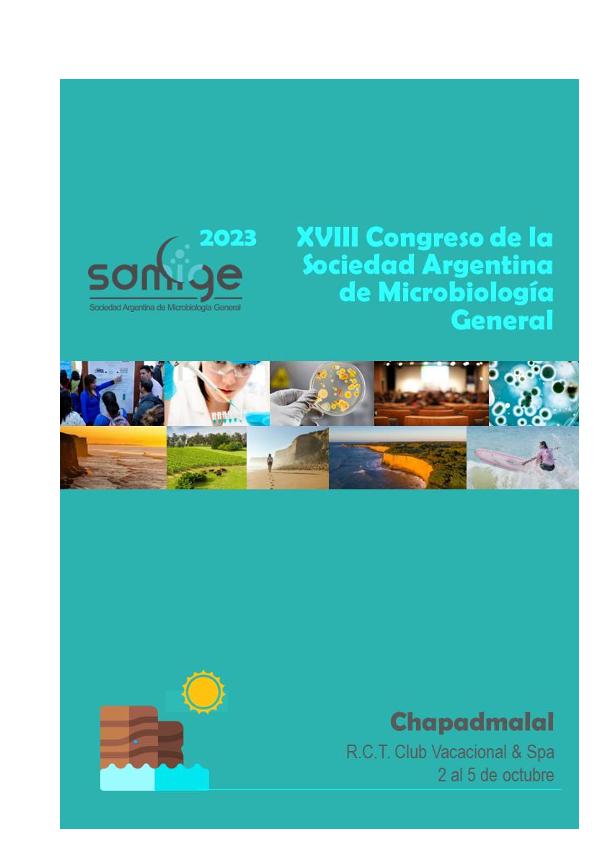Evento
Impact of biocontrol yeast clavispora lusitaniae 146 on the lemon microbiome
Rasuk, Maria Cecilia ; Pisa, José Horacio
; Pisa, José Horacio ; Chacón, Florencia Isabel
; Chacón, Florencia Isabel ; Pereyra, Martina María
; Pereyra, Martina María ; Dib, Julian Rafael
; Dib, Julian Rafael
 ; Pisa, José Horacio
; Pisa, José Horacio ; Chacón, Florencia Isabel
; Chacón, Florencia Isabel ; Pereyra, Martina María
; Pereyra, Martina María ; Dib, Julian Rafael
; Dib, Julian Rafael
Tipo del evento:
Congreso
Nombre del evento:
XVIII Congreso de la Sociedad Argentina de Microbiología General
Fecha del evento:
02/10/2023
Institución Organizadora:
Sociedad Argentina de Microbiología General;
Título del Libro:
Libro de resúmenes del XVIII Congreso de la Sociedad Argentina de Microbiología General
Editorial:
Sociedad Argentina de Microbiología General
Idioma:
Inglés
Clasificación temática:
Resumen
The use of biocontrol agents has been proposed as an effective alternative to reduce citrus decays for promoting sustainable agriculture based on organic fruit production. Among the different microbial biocontrol agents, Clavispora lusitaniae 146 stands out as it is able of effectively controlling green mold in lemons. Although there is growing recognition of the role that the microbiome plays in the health and physiology of many plant species, to date, the composition of the lemon microbiome is unknown, nor is the effect of yeast 146 on it. Thus, the aim of this research was to study the impacts of biocontrol yeast Clavispora lusitaneae 146 on the composition of the lemon microbiome. Lemons were harvested, and then divided into two treatments: untreated and treated lemons with biocontrol yeast C. lusitaneae 146. Fruits were then stored at room temperature for 7 days. DNA was extracted from a pool of 3 pieces of peel per sample, and used for PCR that amplified the bacterial hypervariable V3-V4 region of the 16S rRNA gene. Paired-end sequencing of amplicons was done on an Illumina MiSeq sequencer. To assess the effects of postharvest treatment and storage on the diversity of the lemon microbiome, we used a series of ANOVA and adonis (~PERMANOVA) models with Shannon diversity and community composition as the response variables, respectively. There was no statistically significant difference (KruskalWallies, p > 0.05) in bacterial diversity between the treated and untreated fruits. In this sense, the application of Clavispora lusitaneae 146 did not produce significant changes on bacterial communities of lemons during storage, including alpha diversity, community composition and structure. The bacterial community was dominated by roteobacteria,followed by Firmicutes and Actinobacteria. Specific bacterial taxa were only identified for untreated lemons: Methylobacteriaceae (Alphaproteobacteria) and unclassified bacteria, however in a low abundance. Here, we presented the first lemon microbiome and we showed that the microbial abundance, diversity, and community structures were not significantly different for both treatments, revealing that Clavispora lusitaniae 146 didn´t modify the native bacterial population of the fruit microbiome. The present study is part of larger project whose objectives are to define the complete lemon microbiome, assess the effects of the postharvest biocontrol agents on the composition of the lemon microbiome to develop a science-based strategy for manipulating this microbiome to prevent postharvest decay and physiological disorders.
Palabras clave:
MICROBIOME
,
LEMON
,
BIOCONTROL
Archivos asociados
Licencia
Identificadores
Colecciones
Eventos(PROIMI)
Eventos de PLANTA PILOTO DE PROC.IND.MICROBIOLOGICOS (I)
Eventos de PLANTA PILOTO DE PROC.IND.MICROBIOLOGICOS (I)
Citación
Impact of biocontrol yeast clavispora lusitaniae 146 on the lemon microbiome; XVIII Congreso de la Sociedad Argentina de Microbiología General; Chapadmalal; Argentina; 2023; 184-185
Compartir



